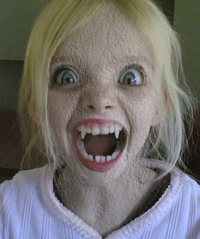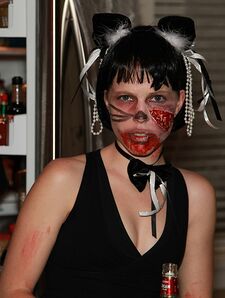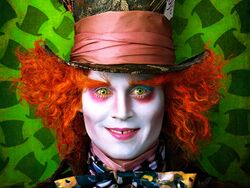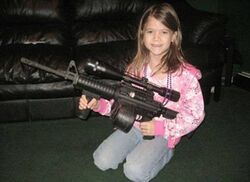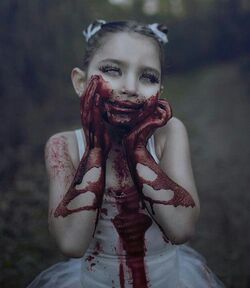Preteen
A preteen, preteenager, or preadolescent is a person in the stage of human development through childhood that is generally said to occur before adolescence. Sociologists and psychologists disagree on the exact definition of "preteen". However, based on Internet image searches, 98.5% of all preteens are girls.[1]
Span
While the range of the preteen years was vague when the term was first used in the 1950s, it is now clearly defined. The preteen years are identified as the ages from 7 to 12,[2] or 8 to 12,[2] or 9 to 12,[2] or 7 to 13,[2] or 8 to 14,[2] or 9 to 15[2], although some sources claim a different age range.[3]
In women's gymnastics, the preteen years are extended to age 18.[4] In pornography, "preteen" includes any woman who appears to be under the age of 23. This article will deal with the clearly defined age range.
Psychological development
Preteen children have a different view of the world from younger children in significant ways.
Realistic view of present and future
The preteen:
- May have a fear of real world dangers like bullies, kidnappers, and snipers who could be anywhere, as opposed to fantasy things (e.g., zombies, vampires and snipers who only hide under the bed).
- Has a more developed sense of looking into the future and predicting the likely effects of their actions (as opposed to younger children who haven't learned astrology).
- Has more realistic job expectations ("I want to be an engineer when I grow up", as opposed to "I want to be a zombie vampire sniper who hides under people's beds").
Responsibility
The preteen:
- Has a different view on morality and necessities, realizing that having the latest doll or toy is not a fundamental necessity, but having the latest Teenz Poppe Starz album is.
- Often has more responsibilities, such as mowing the lawn in summer, shoveling snow in winter, walking dogs in their neighborhood, and dealing drugs at school.
- Is responsible for younger siblings and relatives, becoming a babysitter instead of being babysat, as well as getting younger children hooked on whatever drugs they sell.
Relationships and self-identity
The preteen:
- Views human relationships differently, such as noticing the flawed, human side of authority figures such as parents, teachers and principals.
- Begins to develop a sense of self-identity, seeing themselves as superior to parents, teachers and principals.
- Has increased feelings of independence from ignorant parents, stupid teachers and power-hungry, idiotic and maniacal principals.
Romantic and sexual feelings
The preteen:
- Develops more mature, sensible, realistic thoughts and actions. Instead of falling in love with the Black Stallion in the movie, they may fall in love with the black stallion next door.
- Begins to move out of the "emotional playground", and experiences more mature feelings of limerence, puppy love, or lust outside of the playground.
- Starts caring more about their appearance by wearing fashionable clothing, jewelry including earrings, make up, micro mini-skirts, thongs and bikini tops (this also applies to girls).
- Directs sexual feelings toward a favorite celebrity. Unfortunately, for a preteen girl in many parts of the world, this may be an obstacle in developing a healthy relationship with her husband.
Popular culture
The preteen:
- May become more exposed to, and interested in, popular culture and trends than in childhood.
- Is a primary target of advertisers and marketeers who aim to get their hands in preteens' pockets (figuratively, of course), or, in countries where the average preteen makes less than the annual budget of Zimbabwe, their parents' pockets.
- May, in Western society, become obsessed with pop culture phenomena for preteens such as Disney Channel, celebrities who are older than them such as Justin Bieber, Jamie Lynn Spears and Miley Ray Cyrus, and movies geared toward preteens such as the classics High School Musical, Beauty and the Beast, and The Exorcist.
- May, in Eastern society, discover that older celebrities often become obsessed with them.
Psychologists on preteens
In the 19th century, Sigmund Freud termed preadolescence the latency period, which he saw as a period of unparalleled suppression of sexual desires and erogenous impulses. Modern psychologists point out that Freud made his observations during the Victorian Era, which was a period of unparalleled suppression of sexual desires and erogenous impulses.
But then puberty arrived, and the genitals, which were "the favorite plaything of healthy infants",[5] once again became a central focus of libidinal energy.
Peter Lamborn Wilson, Allen Ginsberg, and other 20th century psychologists claimed that preadolescence or "preteenhood" was not a period of latency. Instead, it was a period of unparalleled possession of sexual desires and erogenous impulses.[6][7] While psychologists for the first time recognized the existence of the pedophile[8] and hebephiliac,[9] the connection between preteen and pedophile/hebephiliac[8][9] was not made until the invention of the Internet.[10]
Modern psychologists such as Robert Anton Wilson III and Alan Moore view the preteen years as a period of unparalleled expression of sexual desires and erogenous impulses. While the pedophile[8] and hebephiliac[9] were originally "driven underground", psychologists now recognize that preteens and pedophiles/hebephiliacs[8][9] have a symbiotic relationship, and that each cannot exist without the other.[11][12]
Tween
Tween is an American neologism and marketing term[13] for "preteen". A blend of between and teen,[14][15] this sometimes refers to the 10 year span between the young teen years of middle school, and the young teen years of adult websites,[15] but it may also refer to preteens.
The term was previously used in J.R.R. Tolkien's 1954 novel The Lord of the Tweens in which it refers to underground-living Hobbits who are in their twenties: "...tweens as Hobbits called the irresponsible twenties between childhood and the coming of age at thirty-three."[16] In this context, the word is a portmanteau of twenty and teen, and has no connection to preteens, the American marketing niche, or to this article. But it does explain marketeers and parents who continue to try to force preteens to act and dress like young women,[1] when they'd really rather dress like zombie vampire snipers who live underground. Or under the bed.
See also
References
- ↑ 1.0 1.1 The remaining 1.5% are male trolls. See Amanda Marcotte's book Troll Nation, Sky Pony Press, 2018.
- ↑ 2.0 2.1 2.2 2.3 2.4 2.5 New Oxford American Dictionary, 2nd Edition. Oxford University Press, 2005.
- ↑ Dobson, Charles.The Healthy Sexualization of Modern Children, 5th Edition. Focus on the Family Press, 2010.
- ↑ "Why Female Olympic Gymnasts Look Like Children". Wordpress (2012 08 02).
- ↑ Freud, Sigmund."Genital Stimulation of the Human Infant" from Three Essays on the Theory of Sexuality (Drei Abhandlungen zur Sexualtheorie). 1905.
- ↑ Dobson, Charles. The Healthy Sexualization of Modern Children, 1st Edition. Focus on the Family Press, 1952.
- ↑ L'Espoir magazine, International Pedophile and Child Emancipation. Centre de recherche et d'information sur l'enfance et la sexualité, 1982-1986
- ↑ 8.0 8.1 8.2 8.3 "Pedophile" is from Latin, "pedo" meaning "child" or "children", and "phile" meaning "person who loves", thus "person who loves children". Oxbridge Latin-English Dictionary, 5th Edition. Oxbridge University Press, 2010.
- ↑ 9.0 9.1 9.2 9.3 "Hebephiliac" is fron Latin, "hebe" meaning "youth" and philiac" meaning "person who loves", thus "person who loves youths". Oxbridge Latin-English Dictionary. 5th Edition. Oxbridge University Press, 2010.
- ↑ Trump, Donald. How I Invented the Internet and Not Al Gore That's Fake News. Trump Tower Press, 1999.
- ↑ Chan, Kuma. The Preteen and The Pedophile: Interdependence as Evidenced in the Nation of Japan. Pedobear Publishing. 2018.
- ↑ Stanford Encyclopedia of Psychology. "Pedophiliac-Preadolescent Symbiosis" and "Hebephile-Preadolescent Symbiosis", 2006.
- ↑ Levasseur, Maïthé. "Familiar with tweens you should be...". The School for Preteen Familiarity of Yoda It Is, (2007-02-09).
- ↑ Merriam-Webster's Collegiate Dictionary. Eleventh Edition. Merriam-Webster, 2003.
- ↑ 15.0 15.1 The American Heritage Dictionary of the English Language, Fourth Edition. Houghton Mifflin Company, 2000.
- ↑ Tolkien, J.R.R. The Lord of the Tweens; The Fellowship of the Tweens, Ballbuster Books, A Division of Random House Inc., 1965.
| Preceded by: Childhood |
Stages of human development Preadolescence |
Succeeded by: Adolescence |
| Featured version: 26 June 2018 | |
| This article has been featured on the main page. — You can vote for or nominate your favourite articles at Uncyclopedia:VFH. | |
